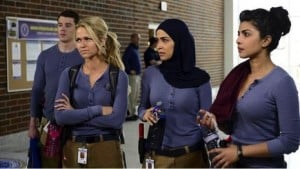
Following a long trial, this month Aafia Siddiqui was convicted of assault with a deadly weapon and attempted murder of U.S. soldiers and FBI agents while being held in custody in Afghanistan in 2008. Known as “Lady al Qaeda,” she was identified in 2004 as the only woman among seven most wanted al Qaeda operatives.
The media coverage of her trial has made much of her extensive psychiatric testing, which eventually concluded that she had faked her mental illness. Doctors stated that she was “intelligent and at times manipulative… [and] showed goal-directed and rational thinking.” In contrast to images of Muslim women, especially those who cover, lacking confidence, Siddiqui’s many outbursts and demands regarding her situation, particularly those relating to her paranoia regarding Jewish people, were trumpeted in headlines internationally, the prosecution even declaring that she was “no shrinking violet” in their closing argument.
In a Vogue magazine article titled “The Most Wanted Woman in the World,” everything—from her education and her strength of character to her mother’s devotion to women’s Islamic rights—is held up as exceptional and ominous. She is uniquely threatening, yet a warning of the neglected danger represented by Muslim women. It is claimed that Siddiqui “sheds light on what psychiatrist and former CIA analyst Marc Sageman calls ‘the neglected role of women’ in motivating men to fight for radical Islamic causes.” Just as in Newsweek’s analysis of Defne Bayrak, Siddiqui has been portrayed as a master manipulator.
Siddiqui has been dubbed “The Mata Hari of al Qaeda” after the notorious convicted spy and femme fatale famed for her “exotic” appeal and alleged use of her sexuality to acquire military secrets. Much like the convicted counterspy, the doubts surrounding Siddiqui’s story enable many narratives to be projected onto her. Claims that her first husband was violently and emotionally abusive to her vie with claims that she was abusive toward her first husband, pushing him towards taking violent action in various conflicts involving Muslims around the world. Speculation about her past abounds in the media, despite her trial being about a matter unrelated to her extremist views or her alleged ties to al Qaeda and actions taken on their behalf. More important than the possibly unknowable truth behind all of the allegations regarding what Aafia Siddiqui has done and what has been done to her is the opportunity to tell a compelling tale, and it seems – in the West, at least – the term “The Grey Lady of Baghram” lost out to “Lady al Qaeda.”
Stereotyping of minority groups is conspicuous in that the group being stereotyped is able to exist in the social consciousness as both harmless and in need of patronizing, as well as uniquely dangerous and subversive. Contrast the white man’s burden and the noble savage with the barbaric native, or the woman in need of patriarchal protection versus the calculating femme fatale rendering men themselves helpless. The stereotype of the Muslim woman who needs to be saved by the secular (or Christian) West from Muslim men, Islam, or patriarchal Islamic culture is well established. But Siddiqui embodies the other side of societal anxieties surrounding Muslim women: the darker reflection of this dichotomy is
“the Menacing Muslim Woman, who unleashes fundamentalism, terrorism, and death wherever she goes.” Rather than requiring protection from a menacing culture or religion, she is the personification of the threat to Western civilization said culture or religion comprises. Ultimately, neither side of this dichotomy is representative of Muslim women as people, nor is the media saturation of these portrayals conducive to anything but fear mongering.
The portrayal of Aafia Siddiqui as a menacing threat to Western civilization is another example of the projection of different narrative onto Muslim women to serve political purposes—often ones that have little to do with the well-being of Muslim women.











